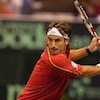One-Handed Backhand
Developing Advanced Tennis Backhand Part II
This is part two of the one-handed backhand tennis drills and corrections which will bring your backhand to a new level, especially in recreational tennis.The first part of developing an advanced one-handed backhand includes drills to help you drive the racquet through the ball straighter, lift the ball to avoid the net, and develop more spin.
This second set of drills focuses on developing a more fluid and natural motion, correcting too much body rotation which happens often with one-handed backhands, using more leg power, and letting go of technical instruction to just focus on the ball's flight.
a) Let go and control the line
As I explain in the video, there is always a danger of being too deliberate and controlled with a new technique so that you don't develop a fluid and effortless movement.
Therefore you need to "break" this controlled movement by just letting go and feeling how you can accelerate the racquet head in the most comfortable and effortless way through the ball.
After a few shots like that, you try to keep this feeling of fluid motion and combine it with the technical task that you need to perform.
b) The non-dominant arm back
A good way to correct too much body rotation when playing a one-handed backhand in tennis is to extend the non-dominant arm backward during the stroke.
This prevents rotation and helps you align your shoulders with the imagined trajectory of the ball that you intend to play.
Extending the non-dominant arm back is especially important when you play a down-the-line shot because you need precision. If you rotate just a little bit too much, you'll play the ball closer to your opponent and get into trouble because there's a long way to cover the court correctly.
c) One and two
This is another drill that helps one-handed backhand players to be more accurate in directing the ball.
The "one" part focuses on keeping the racquet in line with the target and extending along this imaginary line, and "two" is letting the racquet go into the follow-through.
The "one" part means that racquet stays on the same side of the body - for right-handers on the left side - and "two" means that the racquet can cross the body and end up on the right side.
It can feel too forced if you control it very consciously, so I suggest you focus on the "one" more in your mind. Just imagine the straight line and then continue fluidly into the follow-through.
The most common mistake when performing this drill is to allow the racquet to escape the straight line when focusing on "one". You can stop the racquet a few times at the end of "one" and see whether it stays on the left side.
d) Using the legs - "Grounding"
I learned the term "grounding" from a Spanish coach who played ATP professionally for a few years and trained in Spain and USA for many years. This term works much better in my opinion than "bend your knees".
Grounding means that you focus on feeling the ground and pushing off the ground and into the shot. This doesn't necessarily mean that you are in the closed stance and transfer your weight forward.
It merely means that you focus on initiating the stroke from the ground first and transfer this energy through your body into the racquet head.
The key is to really feel the ground before the shot, feel very stable and balanced, and push off and transfer this push into your arms and eventually into the racquet.
e) Copy the forehand
I've often seen players who hit the ball on the forehand side in one way (more speed and more spin) and on the backhand side in another way (less speed and less spin).
This can happen subconsciously for various reasons. The key is to become aware of how you hit the ball on the forehand, and try to copy that with your one-handed backhand.
This is not a technical comparison but a tactical one. You need to compare the speed, spin, height, and depth of the shots. The direction is not so important in this drill - it's more about hitting the ball in the same way.
You need to forget the "correct technique" and just remember how you hit the ball on your forehand side, and then try to copy the ball's flight (speed, height, depth) and spin on your backhand side.
This is another drill that helps you "break" the new technique that you've been working on and allows you to develop feel and effortless motion.
Summary
The more technical drills like "One" and "Two" need to be combined with "Let go" and "Copy the forehand" drills so that you don't just guide and push the ball with "correct technique" but you also make an effective shot.
That's what tennis is about. You don't win points by performing technique correctly. You win points by hitting effective shots.
The technical corrections of the one-handed backhand in this and the previous article guide you towards more consistent and accurate strokes, but you also need the element of natural and effortless movement which often gets lost in technical training.
Therefore always combine technical training with biomechanically comfortable movements in order to find the optimal movement which gives you accuracy and consistency and is at the same time effortless and fluid.
You may also like -








